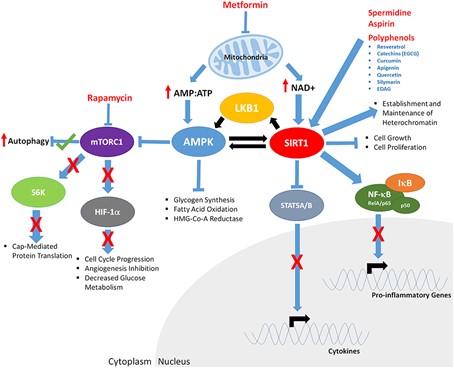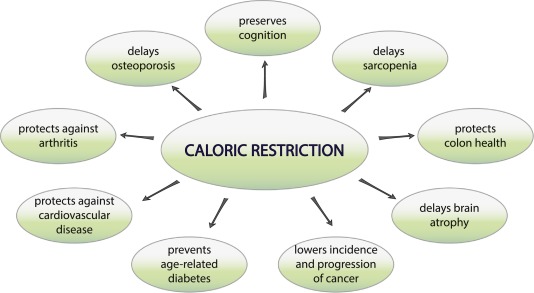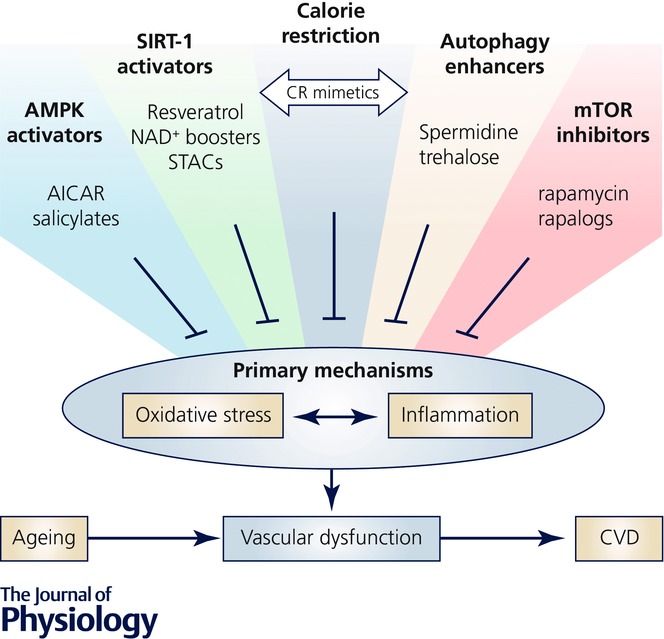Caloric Restriction, Longevity, Fasting and Fasting Mimetics
Calori restriction, To date, caloric restriction (i.e., a reduction in caloric intake without malnutrition) is the only non-genetic intervention that has consistently been found to extend both mean and maximal life span across a variety of species. Thus, findings from animal studies, suggest prolonged caloric restriction has the potential to extend health-span and thereby increase the quality of life. In recent studies conducted in overweight humans, caloric restriction has been shown to improve a number of health outcomes including reducing several cardiac risk factors improving insulin-sensitivity, and enhancing mitochondrial function.
Additionally, prolonged caloric restriction has also been found to reduce oxidative damage to both DNA and RNA. Several different biological mechanisms may account for the increase in health span and longevity such as downregulation of answers to oxidative stress, increased autophagy, senolysis, maintenance of a healthy population of mitochondria though biogenesis.
During fasting, the ratio of AMP to ATP is increased and AMPK is activated, triggering repair and inhibition of anabolic processes. Acetyl coenzyme A (CoA) and NAD+ serve as cofactors for epigenetic modifiers such as SIRTs. SIRTs deacetylate FOXOs and PGC-1α, resulting in the expression of genes involved in stress resistance and mitochondrial biogenesis.
Major theories of the mechanism how CR interacts with aging thus include the oxidative damage attenuation hypothesis, glucose-insulin hypothesis, growth hormone and insulin-like growth factor (IGF)-1, and the hormesis hypothesis.
Additionally, CR and fasting is known to affect the epigenetic machinery including SIRTs which controls many of the hallmarks of aging. CR is able to mediate specific changes in gene methylation profiles as discussed for the epigenetic clock before. Additionally, the activity of epigenetics active metabolites induced or elevated as in CR such as butyrate and BHB contribute to the beneficial effects of CR and fasting. However, long time CR resulting in underweight is obviously not supportive for longevity as several meta-analysis found a J-shaped association between BMI and mortality with the lowest risks at 24kg/m2 [169] .

Intermittent fasting and fasting Mimetics
One alternative dietary approach that may produce similar biological changes as caloric restriction that has received increasing interest from the scientific community is intermittent fasting.Although the magnitude of the effect of intermittent fasting on life-span extension is variable (influenced by sex, diet, and genetic factors), studies in mice and nonhuman primates show consistent effects of caloric restriction on the health span . However, a significant increase of epigenetically active ketone bodies seems to be linked to the length of the intermittent fasting.
Although there is no general agreement on definitions one might discuss to differentiate between short term CR and intermittent fasting protocols and longterm CR and fasting by activation of epigenetic active metabolites in addition to activation of SIRTs.
The strict and life-long compliance with these regimens is difficult, and ways have been investigated to mimic fasting and caloric restriction mechanisms and benefits.
CR and fasting mimetics mimic several molecular consequences of fasting. Main affected pathways include the SIRT, AMPK and mTOR pathway. Polyphenols, Spermidine, and Aspirin increase SIRT1 activity, There are a number of naturally occurring polyphenols, including curcumin, resveratrol, catechins especially EGCG, gallic acid apigenin, quercetin as well as the polyamine spermidine that are discussed as CR/fasting mimetic. [


